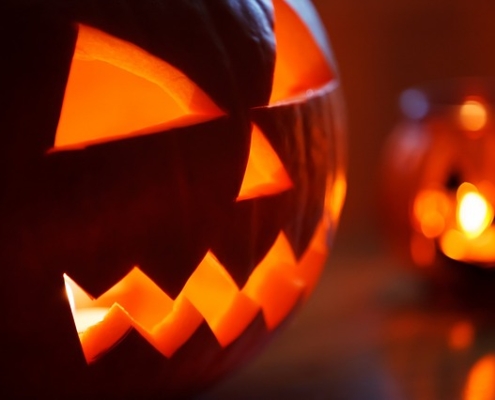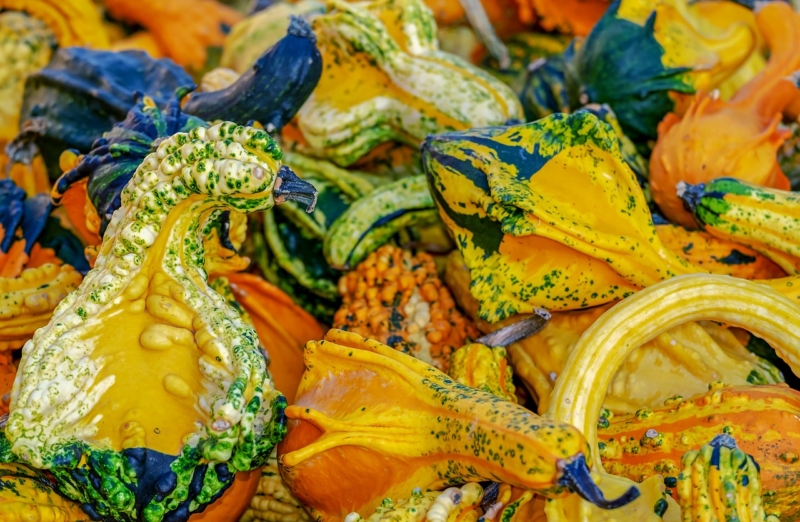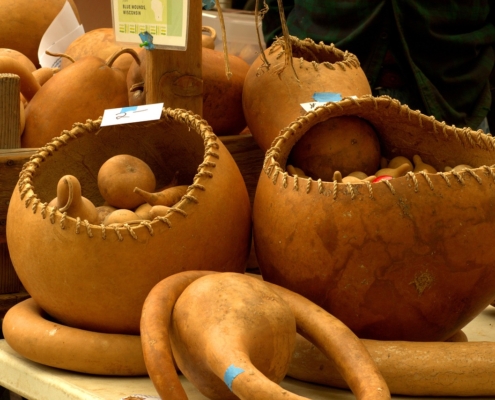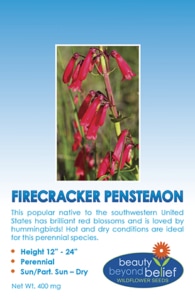The History of the Jack-O-Lantern

photo courtesy of pixabay
by Heather Stone
As the last days of October approach pumpkins carved in an array of faces and lit from within by candles dress porches, stoops, windows and walkways. The jack-o-lantern as we know it is a true American icon of Halloween, but where and how did this tradition begin?
There are several theories on the origin history of the jack-o-lantern. In 17th century Britain, an unknown man or night watchman carrying a lantern was referred to as “Jack of the lantern.”
During the same century in Ireland the “lanterns of Jack” were one of many names to describe the strange phenomenon of lights seen flickering over the peat bogs. These lights are known by many names including the “will o’ the wisps.”

photo courtesy of pixabay
My favorite history of the jack-o-lantern theory is based on an old Irish folktale about a man named Stingy Jack who tricked the Devil. The legend of “Stingy Jack” has many forms. Here is one.
Stingy Jack invited the Devil to have a drink with him, but Stingy Jack didn’t want to pay for his drink, so he convinced the Devil to turn himself into a coin (the Devil being able to take one any form) that Jack could use to buy their drinks. After the Devil turned himself into a coin, Jack decided to keep the money placing it in his pocket. Inside his pocket lay a silver cross preventing the Devil from changing back into his original form. Jack agreed to free the Devil, under the condition that he would not bother Jack for one year. The next year, Jack again tricked the Devil into climbing into a tree to pick a piece of fruit. While he was up in the tree, Jack carved a sign of the cross into the tree’s bark so that the Devil could not come down until the Devil promised Jack not to bother him for ten more years. Eventually, Jack died and legend has it that God would not allow him into heaven and the Devil angry from being tricked didn’t want Jack either. The Devil is said to have sent Jack off into the night with only a burning ember to guide his way. Jack but this ember into a carved out turnip and roams the earth to this day.
In Ireland, folks began carving faces into turnips to ward off Stingy Jack and evil spirits on All Hallow’s Eve. Beets were used in England. This tradition likely came to America with immigrants from these countries. The pumpkin being plentiful here and easy to carve became today’s jack-o-lantern.
Read more about the Queen of Halloween.
All About Gourds
by Heather Stone

Photo courtesy of pixabay – Couleur
Fall is here and pumpkins and gourds can be found in abundance. From the farm stand to the local grocery store, these colorful and sometimes funny shaped fruits are part of the season. But, did you know that gourds are one of the oldest cultivated plants? Originally grown to make storage vessels and utensils, nowadays we largely use them for decoration. A member of the Cucurbit family along with cucumbers, squash and melon, gourds grow on large, vigorous vines that can be trained along fences or up trellises.
Humans around the world have utilized gourds for a very long time for a variety of purposes. Most commonly, gourds were used for storage containers, utensils, dippers and dishes. Gourds were also used for creating musical instruments such as shakers, maracas, drums and various stringed instruments resembling a banjo. Some of the earliest guitars and violins in the United States were made from gourds by African slaves.
There are three types of gourds:
- Cucurbita pepo are the colorful little ornamental gourds that make good decorations.
- Lagenaria siceraria are the hard-shelled gourds . Varieties include the Speckled swan gourds, bottle gourds, dipper gourds, birdhouse gourds and powderhorn gourds. Hard-shelled gourds have been grown for over five thousand years for use as containers, utensils and drinking vessels.
- Luffa aegyptiaca is the well-known bath sponge. When dry, the outer shell is scraped off and the inner fiber is used as a sponge.
Gourds are easy to grow and come in a wide array of colors, shapes and sizes. Sow the seeds in a sunny location after all chance of frost has passed. Gourds will grow in almost any soil and under most conditions. Ideally, train the vines up a trellis or fence to keep the fruits off the ground while ripening and drying. Most gourds reach maturity in 90-150 days. Harvest after the shells harden by cutting the fruits from the vines with 1-2 inches of stem attached. Cure them for a week in a warm, dry location with good air circulation.

photo courtesy of pixabay – mikegoad
To fully dry your gourds for crafting:
- Place gourds in a warm, dark spot.
- Regularly turn your gourds so air reaches all sides.
- When you can hear the seeds rattle inside your gourd, it is fully dry and ready for use.
- This drying period can take several weeks depending on the variety and size of the gourd.
You can create a number of things from your homegrown gourds.
Here’s the how-to for turning that birdhouse gourd into a birdhouse.
Want to make a bowl or two? Here’s a great tutorial.
Sources: http://indianagourdsociety.org/education/Gourds_In_American_History_2010.pdf
Start Your 4th of July Party Now
Firecracker Penstemon
By: Sandy Swegel
Get your Fireworks and start your 4th of July party now. One of my favorite things about perennials is that you plant them once and they bloom year after year. Their appearance every year becomes one of the sweet rituals of the garden. Bright red Firecracker Penstemon is a favorite neighborhood ritual of mine. Some 15 years ago an older lady in the neighborhood planted red firecracker penstemons around her mailbox on the street. She called it the 4th of July flower because the little stand of 3- ft tall red flowers that had grown around her mailbox in the hot beating sun were always in bloom on the 4th of July. Over time, the display got more elaborate as purple salvia were planted at the base of the penstemon. Later white alyssum was growing all around in the rocks. It was a true red white and blue extravaganza.
A few years later I noticed other mailboxes in this suburban neighborhood had firecracker penstemons growing up around them. The whole street was decorated for the 4th of July. I never did find out if everyone liked the idea and planted penstemon too or if some middle of the night guerilla gardener spread penstemon seed everywhere.
Firecracker penstemon is a good choice for mailboxes in the sun next to the street because it tolerates high heat and drought which both plague mailboxes in the sun next to concrete sidewalks. The only caveat is that penstemon is one of those perennials that doesn’t bloom until its second year, so you’ll have to wait a bit for the start of your annual your 4th of July explosion of red.
Photocredits:
https://nargs.org/forum/penstemon-eatoni-eaton-firecracker-or-firecracker-penstemon
http://extension.usu.edu/rangeplants/htm/firecracker-penstemon
Plants as Conversation Starters
All About Plants
by Sandy Swegel
One of the awkward parts of the holiday season is ending up at gatherings where you only know the person you came with and everyone else is a stranger. There’s always the option of getting a plate of food and finding a comfortable chair to sit in and people watch but it can be awkward. I recently had a great time at a party I was going where I didn’t know many people or have much in common with them and it was entirely thanks to plants. So I know you’re supposed to bring a small gift when you are invited to a dinner, but wine or even grocery store flowers can set you back $15- 20 and I’m frugal or cheap or broke, depending on my mindset that day. So I’ve taken to making my own flower arrangements from gathered natural items and thrift store vases. These can turn out quite creative and cute (I used ornamental cabbages as the center “flowers” recently.) or so unusual that my family says things like “What weird thing is that?”
So at this recent party, the hostess took my cabbage flower and evergreen arrangement politely said thank you and put it on an out-of-the-way table. I sat on a comfortable chair with a plate of food and stumbled over small talk. As my mind idly looked around the room I looked up at the ceiling and saw a stray ivy vine tacked up along the beams near the high ceiling. Its pot was on a narrow ledge about ten feet high and I blurted out without thinking, “Who gets up to water that pot?” The husband came over and said proudly, “That’s my job.” And together the two of them started an animated story about this little vine had grown over 40 feet long in just the past year and now was entwined across the ceiling like a spider web or halo over their living space. We had a great bonding conversation about the marvels of this ordinary little vine and its impact on their lives as they had to find new places to attach it every month. They appreciated that I noticed and admired it too.
The nice part of this brief encounter was later in the evening when the hostess stood by the little arrangement I brought and looked at anew and commented how beautiful the cabbage and juniper berries were.
It was a win-win-win situation. We came to appreciate each other in a new way because of how we each appreciated nature. And the ivy? Well, you know how vain plants are…it loved being the center of attention.
You can use plants as a conversation starter in your own home by having unusual plants like a string of pearls or bloomers most people aren’t familiar with like a clivia. At other people’s homes, you can just take a moment to remark on the plants that grow there. Turns out the plants we live with and manage to keep alive are important to us.
Photos:
http://carlaaston.com/designed/swap-holiday-decor-for-indoor-plants
https://www.pinterest.com/pin/41376890297731993/
Gifts FOR the Garden
Gardening Tips
by Sandy Swegel
Growing up in the South, we always had a wrapped gift under the tree just in case we needed an extra gift. This was in part a combination of Southern graciousness and straight-out guilt. What if someone brought us a gift and we didn’t get one for them? Or what if someone brought a guest to Christmas and we felt sad that everyone was opening presents except that person. The extra gift was just perfect to make the holidays smooth and happy for everyone.
This year I’m thinking I need gifts under the tree for the one who gives me so many gifts but I don’t have anything for them. The Earth. The Garden. Gaia. Mother Nature. Whatever name you use.
I was reflecting on the many lists of “Gifts from the Garden” like jellies and preserves, or flower arrangements, or just the pine cones I use instead of bows in gift wrapping. And I thought of all the food the earth gave me. And the daily gift of earthly beauty.
Nature provides naturally for herself so I’m not sure what to give her. Other cultures have traditional gifts in their spiritual rituals. Native Americans offer tobacco or burnt sage, cedar or sweetgrass. Some Hindu traditions offer rice and ghee in fire rituals.
What can we modern Americans offer? A shamanic friend tells me the gift itself isn’t as important as the intention behind the gift. My intention is gratitude and acknowledging that my relationship with Nature is two-way…not just us receiving but also us giving. I haven’t decided yet what to give, but here are some of the gifts I’m considering:
Gifts For the Garden
A Gift for the birds. A feeder for the tiny birds that live in the tree across the street. Or a birdbath heater to provide water when the temperatures are far below freezing in January. The nearest lake or creek or ditch is over a mile away.
A Little Bag of Leaves. This is a symbolic gift to represent all the leaves I left unraked this year in out-of-the-way places….behind the shed, under the deck, in the garden beds…to provide winter homes for the crickets and ladybugs and all the beneficial insects…and even the aphids.
A Bigger Compost Bucket. I love to compost but sometimes in winter, it’s easier just to let things go down the disposal or put it in the City Yard Waste container. It’s still getting recycled, but the garden that gives me so much would probably appreciate extra food for its microbes and earthworms.
A Heart-shaped Stone. A friend collects these while hiking. She has at least twenty rocks in natural heart shapes that she’s run across over the years. She puts them under a tree to remind the earth how much she loves it and appreciates it.
A Little Pair of Shoes. Something for dolls or some discarded kids’ shoes. This would be a reminder to me to walk more often and leave the car at home.
You get the idea. What gift would you like to give Nature in Appreciation this year?
Holiday Gifts for Gardeners
Gift Ideas
by Sandy Swegel
There’s something about winter coming on that sparks the desire to garden. Suddenly we think of all the things we wish we had grown. Or we remember how nice it was to always have a vegetable or flower bouquet to give away. And now what. We want to grow and create to give something.
These are the gifts that I’m giving that I can grow indoors quickly in time for the holidays.
Flowering Amaryllis
A lucky visit to the garden center showed me this year’s casual gift. Amaryllis bulbs already starting to bud right in the box were on sale at 50% off. Amaryllis are ridiculously easy to grow…in soil or in water. I soaked the roots of the bulbs overnight and potted them in plan plastic pots and put them on the windowsill. Once they bloom, I wrap the pot in holiday wrap, add a bow and have awesome gifts ready to go.
Fresh pots of basil.
If you soak basil seeds overnight and plant them densely in clean potting soil in a warm place they’ll germinate very fast. Keep them in a sunny spot or under lights and in two weeks they will be a vigorous aromatic patch of basil micro greens that make a great winter gift.
Vase of coleus
Before your coleus freezes, take lots of cuttings of the most beautiful leaves. Put several stems in a mixed vase. It will be a beautiful arrangement (the reds are quite poinsettia-like.). This is the perfect gift for people who say they have a brown thumb…they just have to monthly refill the water. Those with green thumbs will have rooted plants next Spring.
My favorite gift idea a gardening friend gave last year is pretty hard-core. It is a gift from a serious gardener to another serious gardener. The gift? A bucket of goat manure pellets. Goat manure is one of the best manures…dry, no weeds and not very smelly. I love my eccentric gardening buddies!
Photo credits
http://www.jacksonandperkins.com/amaryllis-bulb-gifts/c/JP-Amaryllis/
https://myurbanfarmscape.com/tag/coleus/
What can a Gardener Do in a SnowStorm?
How to Survive Winter
by Sandy Swegel
Oh my, what a winter. In Colorado we haven’t suffered like the Northeast has…just last week we had five glorious warm sunny days in which I cut back grasses, pruned dormant trees, and started some cleanup. Alas, today, there’s eight inches of snow on top the fence and more coming. What’s a gardener to do?
You can Design a Snow Garden.
OK, come summer you’ll call it a Moon Garden because it will be all white. But I’m been Googling all the plants with “Snow” in their names. One hot summer night this July, I could be surrounded by a field of white flowers that cools me off remembering that snowstorm last February.
My thoughts so far:
Agapanthus SnowStorm
Spirea SnowStorm
Bacopa Giant Snowflake
Alyssum Snowdrift
Then there are the common names: Snow in Summer, Snow on the Mountain, Snow Flower, Snow Drops, Snow Rose, Snow Poppies. There is no end to this pun. But it could be a wonderful whimsical garden that would delight your friends and just glow in the moonlight. Install some garden solar-LED snowmen or snowflakes to come on after dark. You’ll either have the cleverest garden or the most eccentric garden on the block. Either sounds great when you’re stuck in a snowstorm.
http://www.missouribotanicalgarden.org/PlantFinder/FullImageDisplay.aspx?documentid=35248
Heirloom Vegetable Seed
Wildflower Mixes
Grass Mixes
Organic Vegetable Seed
A Valentine’s Day Gift for the Bees
Bee Love
by Sandy Swegel
Nothing like Valentine’s Day to make us think about who and what we love. If we look at the huge number of Facebook “likes” we get when Mike posts about bees or wildflowers, we know our followers have a special love for wildflowers and for the bees and other pollinators who feast on wildflowers.
So how about we all do something special for bees this Valentine’s Day and plant a special Wildflower Patch for them that is a food source both beautiful and safe. A wildflower garden can be a whole meadow or it can be a tiny corner of your garden. Size isn’t as important as a good source of food that’s grown from seed naturally.
We’ve written here before about the dangers of the neonicotinoid pesticides (now more easily named neonics.) The bottom line is that if you buy plants, it is likely they were treated with neonics at some point in the greenhouses where they are propagated and grown for sale. Neonics are good killers and control the aphids, mealy bugs, scale and thrips that plague crowded unnatural greenhouse conditions. It’s much for expensive for big growers to treat pests naturally when mass spraying of neonics takes care of the problem for them cheaply. The cost to the bees doesn’t factor into the budget.
But for bees, it’s starting to look like even small amounts of neonic residue left in plants can hurt them. See the link below for the Harvard study that found that healthy bees that were exposed to even sublethal doses of neonics were significantly less likely to survive winter.
The only way to protect the bees until neonics are outlawed here as they are in Europe is to make sure they have natural sources of flowers that are grown from seeds instead of from purchased plants. And the best plants to grow are the ones bees have evolved with: Wildflowers. Anyone who gardens that knows that Wildflowers are a real “if you plant it they will come” experience. Every pesticide free wildflower you plant will be covered with happy bees.
So our Valentine’s message is this:
“Bees, We Love you. We want to show you our love in a time-honored way humans have always shown love: we want to feed you lots of good food: the pollen and nectar from naturally grown wildflowers. We want you to be healthy and happy and share many more Valentine’s Days with us.”
Harvard study:
http://www.hsph.harvard.edu/news/press-releases/study-strengthens-link-between-neonicotinoids-and-collapse-of-honey-bee-colonies/
Photo credit:
http://www.sweetcomments.net/picture/valentines-day/bee-valentine.gif.html
Best Free Seed Starting Container Ever
Seed Starting Tips
By Sandy Swegel
If truth be told, growing seeds and especially food is really just a hobby for me. I do it quite earnestly and often obsessively, but it’s not like I’m not going to eat if I don’t grow my own food. That has not always been true for my ancestors or for people around the world. If they don’t grow their own gardens, they don’t eat. And they don’t have extra money to buy fancy seed-germinating setups.
A great-grandmother I met described for me how she went about seed starting back in the Depression of the 1930s living on the plains in Colorado. It’s a method that she still uses because it works so well and costs nothing. In her retirement she lives in a city townhome and but she still gardens in big pots on her patio…and each Spring she has egg-carton trays full of eggs with seedlings on her windowsill.
We’ve often heard of putting potting soil right into egg cartons. But if you plant right into the eggshell, you don’t end up with broken soggy cartons…and you putting calcium right into the garden where you need it. People who keep earthworms know that earthworms need calcium for reproduction. Eggshells in compost and in the soil make for more earthworms and better soil.
It’s super simple to start your seeds in eggshells. Save some egg shells. You’ll want to rinse them out or you’ll get that nasty sulfur smell if you leave old egg inside. Use a pin to pierce a hole or two in the bottom. Fill with some clean potting or germinating soil. That’s it. Absolutely free. Put the eggs into an egg carton on a bright warm windowsill. The eggs keep moisture in much better than the carton would. When it’s time to plant just crumble the base of the eggshell right into the garden before planting.
I sometimes get the clear plastic egg cartons. Those are really useful because the closed plastic makes a great tiny greenhouse.
You already know how to save money if you’re growing seeds. Growing from seed means each plant costs you pennies instead of dollars when you buy plants. Now you don’t have to pay for the seed containers either.
And if you time it right, you can have super cute eggs full of tiny seedlings for table decorations.
Photo Credits
http://foodstorageandbeyond.com/2011/03/feature-friday-eggshell-seed-starting-pots/
Best Heirloom Vegetable Seed
Wildflower Seed
Wildflower Seed Mixes
Grass Mixes

